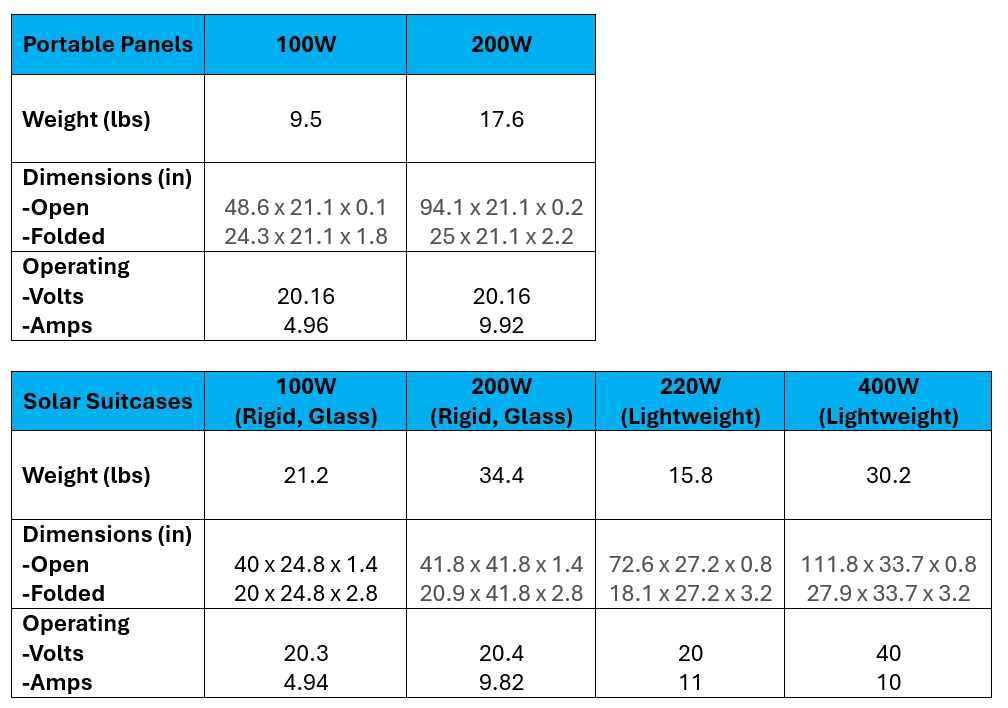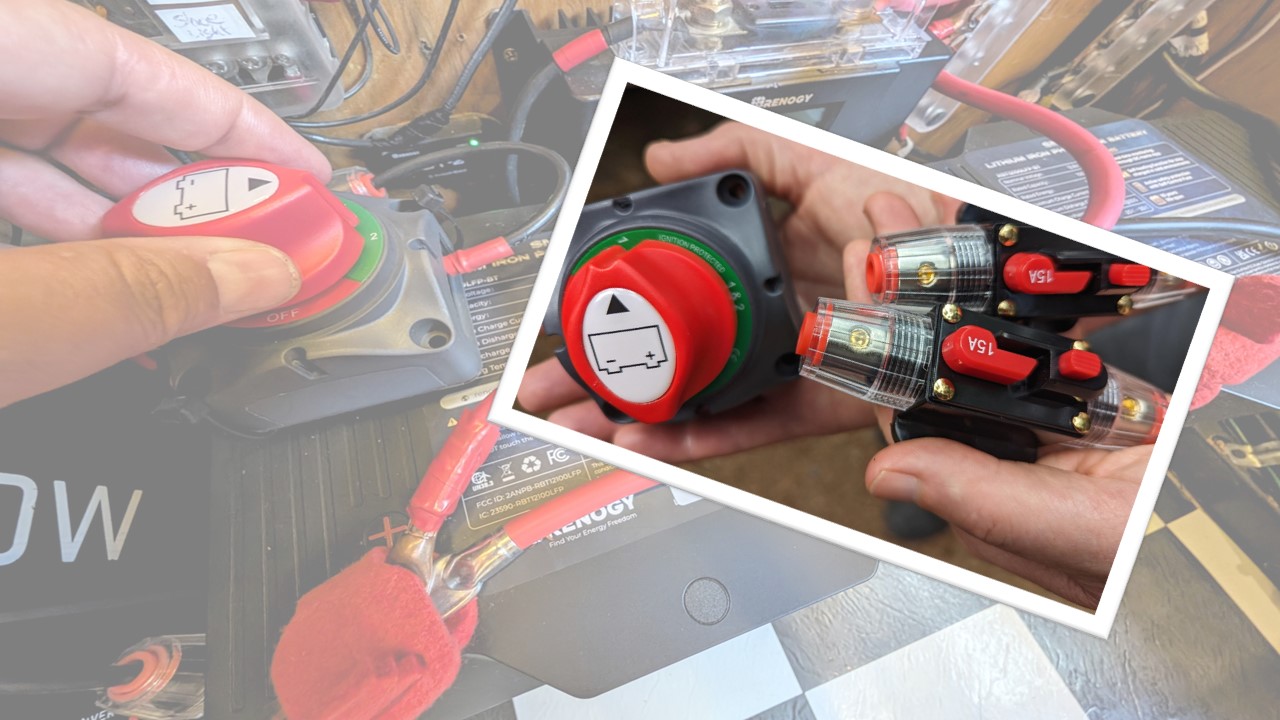Summertime Strategies for Staying Cool with RV Solar
Summer is a great time to take your solar-powered RV or van into a gorgeous, off-grid location! The sun angle is high and there’s plenty of daylight hours to optimally charge your RV batteries using rooftop panels. But, after living full-time in our camper for nearly 12 years now, we have found that the ONLY drawback to solar is needing to be parked in the full sun. From May through September, a relaxing camping trip can become brutally hot depending on where you are adventuring.
So, how can you take advantage of parking your rig in the shade to keep it cooler, save money by staying in off-grid campgrounds, and also run completely on solar? Renogy portable panels to the rescue! We’ve spent the last month in the greater Yosemite National Park area, deep in the gorgeous Sierra Mountains. The conifer and oak forests in this part of central California provide necessary shade from the extreme heat, making camping in the summertime pleasant. With the help of the forest canopy, our rig stays cool inside – preventing us from using all of our precious solar energy just to cool it down. But, our rooftop array stays completely shaded.
With one simple “hack” we switch our solar collection from our rooftop array consisting of 2 x 100W flexible panels to our lightweight 400W solar suitcase (with an extension cord). This portable panel keeps our batteries charged, so that we can continue to run all of our appliances without needing an electrical hook-up, even in the heat of the summer. Check out our #1 off-grid hack to maximize solar power on a small rig:
And, choosing an off-grid campground saves us a ton of money! Paying $10/night for a spacious campsite along the river without electrical hook-ups is far more appealing than a crowded RV park or state park with electricity that charges upwards of $50/night. By powering our rig with solar, we estimate that we’ve saved over $200K on camping fees over the past 12 years on the road!
What are the Main Differences between E.Flex Series Portable Panels & Solar Suitcases?
While both of these styles are portable solar panels, E.Flex portable panels are typically made from lighter weight materials, allowing you to get more wattage per pound. They are specifically designed for easy portability, featuring ultra-thin panels and lightweight kickstands. However, this lightweight design comes with a trade-off in durability, potentially leading to slightly lower efficiency compared to traditional suitcase-style panels. Alternatively, solar suitcases are more similar to more traditional solar panels (only hinged in the middle to make them foldable) and have an integrated, durable stand or kickstand. Overall, they are a bit more heavy duty. Both styles of panels are sturdy, efficient, and fold up into their own durable cover or case. Now, Renogy has introduced a new lightweight series of solar suitcases, available in 400W and 220W specifications. These models combine portability and durability, are waterproof, and come with a five-year warranty. The 400W Lightweight Portable Solar Suitcase delivers high power output and efficiency at just 30.2 lbs. Designed for more demanding applications, this product features advanced construction with superior fiberglass material. This robust design enables the suitcase to withstand light hail and strong wind. Additionally, the 400W lightweight suitcase is equipped with durable aluminum alloy kickstands that enhance stability during movement and folding, ensuring reliable and efficient power generation.
What Should I Consider When Choosing an E.Flex Series Portable Panel or Solar Suitcase?
There are a few considerations when choosing the best portable solar panel or solar suitcase for your mobile lifestyle. Make sure the panel:
- Fits your energy needs. See our Solar System Sizing Worksheet to determine your average daily watts hours
- Fits your available storage space (when not in use)
- Integrates appropriately with your rooftop array (if applicable)
- Is a size and weight that you can easily lift and adjust throughout the day
How Do You Combine Portable Panels with Rooftop Arrays?
Renogy portable panels can be used by themselves or in conjunction with any rooftop system. Panels ranging from 100W to 400W are ideal for RV’s and vans. In addition to allowing you to park in the shade, and still be able to charge with solar, these panels are the perfect way to quickly add some additional surface area to your overall system during low solar days (and work very well in the fall, winter, and spring when the sun angle is lower in the sky). When combining arrays together, you should always choose panels of the same wattage.

Here are a few options for combining rooftop arrays with a portable panel or solar suitcase on an extension cord:
Plug & Play Options:
- If you have a battery bank on the tongue of your 5th wheel or travel trailer, you can simply use the provided alligator clips to attach the solar suitcase (with integrated charge controller) directly to your battery bank.
- If you have a “solar ready” port on the side of your rig, use the included MC4 connectors and an appropriate adapter (if needed) to plug the solar suitcase (with integrated charge controller) into the port. See this video for details.
System Integration Options:
If your battery bank is stored inside your rig rather than on the tongue, simply create an external wire “pigtail” with one end connected to the battery terminals (or DC bus bars) inside and either MC4 or Anderson connectors on the other end so that you can quickly connect a portable solar panel when you need it. This integration can be accomplished in a few ways:
- No rooftop panels, no charge controller inside. You will need a solar suitcase with an integrated charge controller to connect to your RV pigtail or solar port.
- Integrated rooftop panels, charge controller, same panel wattages. You can combine a rooftop array and a portable panel into the same charge controller inside your rig, but only if two conditions exist: 1) the total possible current (amperage) doesn’t exceed the limits of your charge controller AND 2) the wattage of the individual rooftop panel(s) and portable panel(s) are the same (or very similar). For instance, we combined our 2 x 100W flexible panels on the roof with a 100W solar suitcase – allowing us to increase our solar collection by 100W on lower solar days. To do this, use a positive bus bar to bring both positive, fused wires from each array together; and a negative bus bar to combine the negative wires. Then wire both the positive and negative bus bars to the charge controller. Alternatively, you can use Y-branch connectors with an inline fuse to combine the positive and negative wires together, then run them directly to the charge controller.

- Integrated rooftop panels, charge controller, different panel wattages. However, if your rooftop array and portable panel wattages are different (e.g., 2 x 100W on the roof combined with a 400W portable panel), you can install a simple battery switch and a couple of circuit breaker switches as shown in the video above to connect either your rooftop array OR your portable panel / solar suitcase to a single charge controller inside your rig. This is the perfect solution for us when we have our rig in the shade. When we put our 400W Lightweight Portable Panel out in the sun, it keeps our 2 x 100Ah LiFePO4 PRO battery bank topped up while we use our laptops and satellite internet for work during the day. Then, when we want to use our lights, fan, and other electric appliances at night, we have plenty of energy left in our battery bank.
- Separate charge controllers. You can also combine a rooftop array and a portable panel with an integrated charge controller and skip the combination altogether. One charge controller (located inside your rig) can monitor your rooftop array, while the other is permanently attached to the solar suitcase, as shown in this video.
How Much Do E.Flex Series Portable Panels & Solar Suitcases Weigh?
Something to keep in mind with E.Flex portable panels and solar suitcases is that you might have to relocate the panel for optimal charging as the sun crosses the sky throughout the day. For some people, the size and weight of these panels can be difficult to manage, so this should be an important factor when determining which style and size is best for you. At approximately 17.6 lbs, Renogy’s E.Flex 200W portable panel is relatively lightweight and easy for most folks to move, but their Lightweight 400W solar suitcase weighing in at 30 lbs could be a struggle for some less able-bodied folks. It’s best to always fold up the panel before moving it to a new location.
So, start planning that summer camping adventure now! With many hours of sunlight and the high solar angle in the northern hemisphere, solar production is at its peak. Portable panels and solar suitcases are the secret tool for maximizing the best of summer sun and keeping things cool inside your rig. Happy camping!

Shari Galiardi & David Hutchison have turned their higher education backgrounds, desire for life-long learning, and thirst for adventure travel into writing, photography, video production, and public speaking tours from coast to coast. Known to their friends as simply Shari & Hutch, you can learn more about their full-time, solar powered adventures on their website at freedominacan.com. Or, follow them on Facebook, Instagram, and YouTube as "Freedom in a Can."Save an additional 10% off most products using our promo code CANLIFE - even on sale items!











